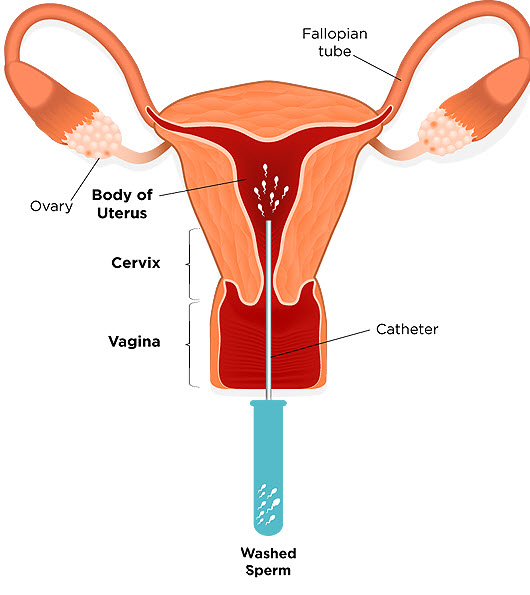Examples of reasons for intrauterine insemination
- Inability to have penis-in-vagina sex, e.g. due to a physical or psychosexual disability.
- One of the partners in a relationship has a sexually transmitted disease (e.g. HIV) that makes it unsafe to have unprotected penis-in-vagina sex.
- Wishing to achieve conception using donated sperm.
Testing
Clinics that carry out IUI:s will typically require fertility testing before any IUI is scheduled, in order to determine if an IUI is the most suitable fertility treatment. The woman’s fallopian tubes must for instance be open for an IUI to work. IUI:s are normally not done when the infertility is wholly or partly due to low sperm count or poor-quality sperm. When a woman has mild endometriosis, doing an IUI will not increase her chances of getting pregnant compared with natural attempts.

When?
To increase the chance of conception, the intrauterine insemination is typically done right after ovulation.
Exactly when ovulation takes place after a woman’s period can vary a lot between different women, and sometimes even from one cycle to the next for an individual. You might have heard sayings such as “ovulation takes place two weeks after a woman’s period” but this is an oversimplification. An ovulation prediction kit (OPK) can be used to predict the next ovulation. With a standard OPK, urine or saliva is tested for hormonal content. Blood tests will also work to predict ovulation, but are a bit more invasive.
Stimulated or unstimulated cycle
The IUI can be done after a natural (unstimulated) ovulation or after one stimulated by medical treatment.
In the case of a stimulated ovulation, a vaginal utralsound scan is used to track the development of the woman’s eggs, and when an egg is mature a hormon injection is given to stimulate ovulation.
Stimulating ovulation increases the risk of a condition named ovarian hyperstimulation syndrome. The stimulation also increases the risk of two or more eggs being released and fertilized instead of just one. A pregnancy with more than one fetus comes with increased risks for both the fetuses and the woman.
The procedure
- The vagina is kept open with a speculum.
- A catheter is guided through the vagina and into the uterus. This will normally not hurt, but some patients experience mild cramping similar to period pains.
- Sperm is injected through the catheter.
- The whole procedure will usually take 10 minutes or less. After a short rest, the woman can leave the clinic.
Examples of factors that can impact the chance of success
- The reason or reasons behind the fertility problem
- The age of the woman
- Ovulation stimulation
- Sperm count
- Sperm quality
Statistically speaking, fresh sperm results in a higher success rate than frozen sperm.
